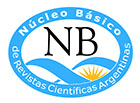Survival and Adaptation of Grassroots Activism at the Unión Cívica Radical Party in the City Of Buenos Aires
Keywords:
Activism, Argentine radicalismo, Local Politics, Political PartiesAbstract
This article aims to analyze the conditions that make possible the persistence of a grassroots committees structure, born in the early twentieth century, in the Unión Cívica Radical, the oldest Argentine party. Our findings are based on fieldwork conducted between 2017 and 2018 in the City of Buenos Aires using qualitative research methods such as in-depth interviews, direct observations in party events, and documents and web pages content analysis. It argues that grassroots committees survive as central institutions of party life because activists and local leaders find in party’s formal and informal organization, incentives for reproducing them. The article shows that grassroots committees are still relevant for intra-party competition, internal groups formation and political career building, as well as for intergenerational transmission of party culture, political socialization of young activists and their acquisition of certain skills of the political job.
Downloads
References
Abal Medina, J. (2009). The rise and fall of the Argentine Centre-Left: the crisis of Frente Grande. Party Politics, 15(3), 357-375.
Acha, O. (2004). Sociedad civil y sociedad política durante el primer peronismo. Desarrollo Económico, 44(174), 199-230.
Adamovsky, E. (2009). Acerca de la relación entre el Radicalismo argentino y la “clase media” (una vez más). Hispanic American Historical Review, 89(2), 209-251.
Alonso, P. (2000) Entre la revolución y las urnas. Los orígenes de la Unión Cívica Radical y la política argentina en los años noventa. Buenos Aires: Sudamericana.
Annunziata, R. (2013). La figura del “hombre común” en el marco de la legitimidad de proximidad: ¿un nuevo sujeto político? Astrolabio, 10, 127-155.
Anria, S. (2018). When Movements Become Parties. The Bolivian MAS in Comparative Perspective. Nueva York: Cambridge.
Auyero, J. (1997). Evita como performance. Mediación y resolución de problemas entre los pobres urbanos del Gran Buenos Aires. En J. Auyero (ed.), ¿Favores por votos? Estudios sobre el clientelismo político contemporáneo (pp. 167-217). Buenos Aires: Losada.
Auyero, J. (2001). La política de los pobres. Las prácticas clientelistas del peronismo. Buenos Aires: Manantial.
Camarero, H. (2011). Perfiles de una organización política obrerista. Proletarización, células de base y subjetividad militante revolucionaria en las primeras décadas del Partido Comunista Argentino. En P. Pérez Branda (ed.). Partidos y micropolítica. Investigaciones históricas sobre partidos políticos en la Argentina del siglo XX (pp. 83-113). Mar del Plata: Ediciones Suárez.
Cyr, J. (2017). The Fates of Political Parties. Institutional Crisis, Continuity, and Change in Latin America. Cambridge: Cambridge University Press.
Dalton, R. y Wattenberg, M. (2002) (eds.). Parties without Partisans: Political Change in Advanced Industrial Democracies. Oxford: Oxford Press.
Ferrari, M. (2008). Los políticos en la Argentina radical. Prácticas políticas y construcción de poder. Buenos Aires: Siglo XXI.
Freidenberg, F. y Levitsky, S. (2007). Organización informal de los partidos en América Latina. Desarrollo Económico, 46(184), 539-568.
Grandinetti, J. (2019). Sociabilidad católica y práctica política en la organización juvenil del partido Propuesta Republicana (PRO). Revista de Sociología e Política, 27(70), 1-20.
Gutiérrez, L. y Romero, L. (1989). Sociedades barriales, bibliotecas populares y cultura de los sectores populares: Buenos Aires,1920-1945. Desarrollo Económico, 29(113), 33-62.
Helmke, G. y Levitsky, S. (2008). Informal Institutions and Comparative Politics: A Research Agenda. Perspectives on Politics, 2(4), 725-740.
Katz, R. y Mair, P. (1995). Changing models of party organization and party democracy: the emergence of the cartel party. Party Politics, 1(1), 5-28.
Katz, R. y Mair, P. (2002). The ascendancy of the party public office: party organizational change in twentiethcentury democracies. En R. Gunther, J. Montero y J. Linz (eds.), Political Parties: Old Concepts and New Challenges (pp.113-135). Oxford: Oxford University Press.
Katz, R. y Mair, P. (2009). The cartel party thesis: a restatement. Perspectives on Politics, 7(4), 753-766.
Kirchheimer, O. (1980). El camino hacia el partido de todo el mundo. En K. Lenk y F. Neumann (eds.), Teoría y sociología críticas de los partidos políticos (pp. 328-247). Barcelona: Anagrama.
Levitsky, S. (2005). La transformación del justicialismo. Del partido sindical al partido clientelista 1983-1999. Buenos Aires: Siglo XXI.
Levitsky, S., Loxton, J., y Van Dyck, B. (2016). Introduction: Challenges of Party-Building in Latin America. En Levitsky, S., Loxton, J., Van Dyck, B. y Domínguez, J. (eds.), Challenges of Party-Building in Latin America (pp. 1-50). Cambridge: Cambridge University Press.
Lichtmajer, L. (2011). La UCR frente al triunfo peronista. Centralización partidaria, declive de los comités y depuración de las prácticas políticas (1942-1951). En Pérez Branda, P. (ed.), Partidos y micropolítica. Investigaciones históricas sobre partidos políticos en la Argentina del siglo XX (pp. 133-165). Mar del Plata: Ediciones Suárez.
Lupu, N. (2016). Party Brands in Crisis. Partisanship, Brand Dilution, and the Breakdown of Political Parties in Latin America. Cambridge: Cambridge University Press.
Lupu, N. y Stokes, S. (2009). The social bases of political parties in Argentina, 1912–2003. Latin American Research Review, 44(1), 58-87.
Mair, P. y van Biezen, I. (2001). Party membership in twenty European democracies, 1980-2000. Party Politics, 7(1), 5-21.
Malamud, A. (1994). ¿Longevidad o senectud? El radicalismo: perfil y perspectivas de un partido en crisis. La Ciudad Futura. Revista de Cultura Socialista, 39.
Mauro, S. (2012). Coaliciones sin partidos. La ciudad de Buenos Aires luego de la crisis de 2001. Política, 50(1), 145-166.
Obradovich, G. (2016). La conversión de los fieles: la desvinculación electoral de las clases medias de la Unión Cívica Radical. Buenos Aires: Teseo.
Ollier, M. (2001). Las coaliciones políticas en la Argentina. El caso de la Alianza. Buenos Aires: FCE.
Panebianco, A. (1988). Political Parties: Organization and Power. Cambridge: Cambridge University Press.
Pedrosa, F. (2004). De eso no se habla… Política informal en las organizaciones partidarias: la Unión Cívica Radical (1983-2003) (tesis inédita de maestría). Universidad de Salamanca, Salamanca, España.
Pérez Bentancur, V., Piñeiro Rodríguez, R., y Rosenblatt, F. (2019). How party activism survives. Uruguay’s Frente Amplio. Cambridge: Cambridge University Press.
Pérez Branda, P. (2011). Los centros socialistas y sus dirigentes durante la crisis partidaria de 1927. El nacimiento del Partido Socialista Independiente. En Pérez Branda, P. (ed.), Partidos y micropolítica. Investigaciones históricas sobre partidos políticos en la Argentina del siglo XX (pp. 53-81). Mar del Plata: Ediciones Suárez.
Persello, V. (2004). El Partido Radical. Gobierno y oposición. 1930-1943. Buenos Aires: Siglo XXI.
Persello, V. (2007). Historia del Radicalismo. Buenos Aires: Edhasa.
Quiroga, N. (2008). Las Unidades Básicas durante el primer peronismo. Cuatro notas sobre el Partido Peronista a nivel local. Nuevo Mundo Mundos Nuevos [en línea]. Recuperado de: http://journals. openedition.org/nuevomundo/30565
Rock, D. (1972). Machine Politics in Buenos Aires and the Argentine Radical Party, 1912-1930. Journal of Latin American Studies, 4(2), 233-256.
Rock, D. (2001). El radicalismo argentino 1890-1930. Buenos Aires: Amorrortu.
Romero, L. y Gutiérrez, L. (2007). Sectores populares, cultura y política. Buenos Aires en la entreguerra. Buenos Aires: Siglo XXI.
Scarrow, S. y Gezgor, B. (2010). Declining memberships, changing members? European political party members in a new era. Party Politics, 16(6), 823-843.
Van Dyck, B. (2014). Why Party Organization Still Matters: The Workers’ Party in Northeastern Brazil. Latin American Politics and Society, 56(2), 1-26.
Van Haute, E. y Gauja, A. (2015). Introduction: party membership and activism. En E. Van Haute y A. Gauja (eds), Party Members and Activists (pp. 1-16). Abingdon: Routledge.
Vázquez, M., Vommaro, P., Núñez, P. y Blanco, R. (eds.) (2017). Militancias juveniles en la Argentina democrática. Trayectorias, espacios y figuras de activismo. Buenos Aires: Imago Mundi.
Vommaro, G. y Morresi, S. (2015). “La Ciudad nos une”. La construcción de PRO en el espacio político argentino. En Vommaro, G. y Morresi, S. (eds.), “Hagamos equipo”. PRO y la construcción de la nueva derecha en Argentina (pp. 29-71). Los Polvorines: Ediciones UNGS.
Whiteley, P. (2011). Is the party over? The decline of party activism and membership across the democratic world. Party Politics, 17(1), 21-44.
Zelaznik, J. (2013). Unión Cívica Radical: entre el Tercer Movimiento Histórico y la lucha por la subsistencia. Revista SAAP, 7(2), 423-431.
Downloads
Published
How to Cite
Issue
Section
License

This work is licensed under a Creative Commons Attribution-NonCommercial-ShareAlike 4.0 International License.
Manuscript acceptance by the Journal implies the simultaneous non-submission to any other journal or publishing house, and the non-exclusive transmission of the author´s patrimonial rights in favor of the editor, who allows the post-print version use, under the Licencia Creative Commnos Atribución-NoComercial-Compartir Obras Derivadas Igual 4.0 Internacional (CC-BY-NC.SA 4.0) (http://creativecommons.org/licences/by-nc-sa/4.0/deed.es). Articles can be shared, copied, distributed, modified, altered, transformed into a derivative work, executed and publicly communicated, provided a) the authors and the original publication (Journal, Publisher and URL) are mentioned, b) they are not used for commercial purposes, c) the same terms of the license are maintained.
It is hereby stated that the mentioned manuscript has not been published and that it is not being printed in any other national or foreign journal.
The authors hereby accept the necessary modifications, suggested by the reviewers, in order to adapt the manuscript to the style and publication rules of this Journal.









